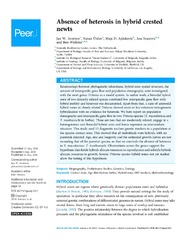Приказ основних података о документу
Absence of heterosis in hybrid crested newts
| dc.creator | Arntzen, Jan W. | |
| dc.creator | Üzüm, Nazan | |
| dc.creator | Ajduković, Maja | |
| dc.creator | Ivanović, Ana | |
| dc.creator | Wielstra, Ben | |
| dc.date.accessioned | 2018-08-09T12:07:37Z | |
| dc.date.available | 2018-08-09T12:07:37Z | |
| dc.date.issued | 2018 | |
| dc.identifier.issn | 2167-8359 | |
| dc.identifier.uri | https://peerj.com/articles/5317 | |
| dc.identifier.uri | https://radar.ibiss.bg.ac.rs/handle/123456789/3120 | |
| dc.description.abstract | Relationships between phylogenetic relatedness, hybrid zone spatial structure, the amount of interspecific gene flow and population demography were investigated, with the newt genus Triturus as a model system. In earlier work, a bimodal hybrid zone of two distantly related species combined low interspecific gene flow with hybrid sterility and heterosis was documented. Apart from that, a suite of unimodal hybrid zones in closely related Triturus showed more or less extensive introgressive hybridization with no evidence for heterosis. We here report on population demography and interspecific gene flow in two Triturus species ( T. macedonicus and T. ivanbureschi in Serbia). These are two that are moderately related, engage in a heterogeneous uni-/bimodal hybrid zone and hence represent an intermediate situation. This study used 13 diagnostic nuclear genetic markers in a population at the species contact zone. This showed that all individuals were hybrids, with no parentals detected. Age, size and longevity and the estimated growth curves are not exceeding that of the parental species, so that we conclude the absence of heterosis in T. macedonicus – T. ivanbureschi . Observations across the genus support the hypothesis that fertile hybrids allocate resources to reproduction and infertile hybrids allocate resources to growth. Several Triturus species hybrid zones not yet studied allow the testing of this hypothesis. | en |
| dc.relation | info:eu-repo/grantAgreement/MESTD/Basic Research (BR or ON)/173043/RS// | |
| dc.rights | openAccess | |
| dc.rights.uri | https://creativecommons.org/licenses/by/4.0/ | |
| dc.source | PeerJ | |
| dc.subject | Age distribution | |
| dc.subject | Contact zone | |
| dc.subject | Hybrid zone | |
| dc.subject | SNP markers | |
| dc.subject | Serbia | |
| dc.subject | Skeletochronology | |
| dc.title | Absence of heterosis in hybrid crested newts | en |
| dc.type | article | en |
| dc.rights.license | BY | |
| dcterms.abstract | Ивановић, Aна; Wиелстра, Бен; Aјдуковић, Маја; Üзüм, Назан; Aрнтзен, Јан W.; | |
| dc.rights.holder | © 2018 Arntzen et al. | |
| dc.citation.volume | 6 | |
| dc.identifier.doi | 10.7717/peerj.5317 | |
| dc.identifier.pmid | 30065885 | |
| dc.identifier.scopus | 2-s2.0-85050617697 | |
| dc.identifier.wos | 000439653900007 | |
| dc.citation.apa | Arntzen, J. W., Üzüm, N., Ajduković, M. D., Ivanović, A., & Wielstra, B. (2018). Absence of heterosis in hybrid crested newts. PeerJ, 6, e5317. | |
| dc.citation.vancouver | Arntzen JW, Üzüm N, Ajduković MD, Ivanović A, Wielstra B. Absence of heterosis in hybrid crested newts. PeerJ. 2018;6:e5317. | |
| dc.citation.spage | e5317 | |
| dc.type.version | publishedVersion | en |
| dc.identifier.fulltext | https://radar.ibiss.bg.ac.rs//bitstream/id/4434/PeerJ_2018_6_e5317.pdf | |
| dc.citation.rank | M21 |

